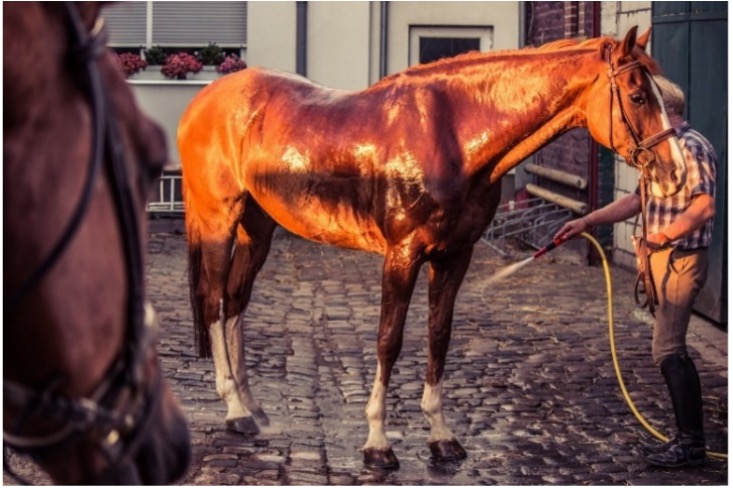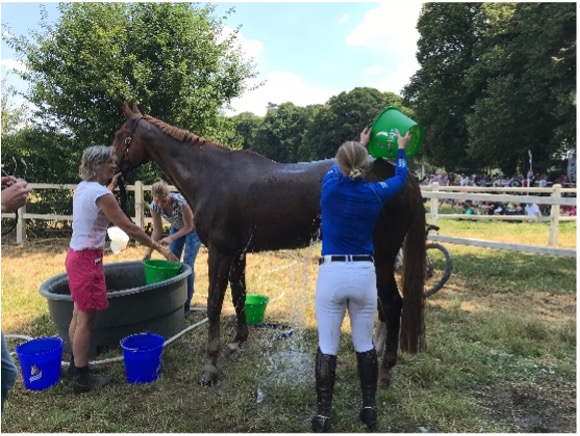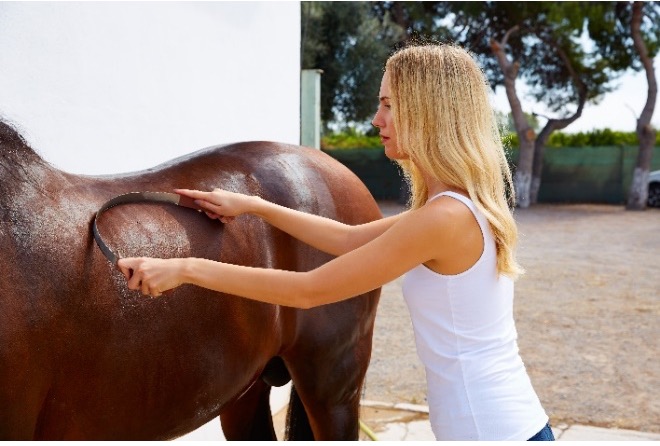Cooling Your Horse: Effective Strategies to Beat the Heat
Horses are particularly vulnerable to overheating because they warm up faster and cool down more slowly than humans. When a horse becomes too warm, it’s crucial to take proactive steps to bring its body temperature down as quickly as possible. But how can you cool your horse effectively, and what should you keep in mind?
When Should You Start Cooling Your Horse?
Horses struggle more than we do with high ambient temperatures (>30°C) and humidity levels (>75%) (Lindinger & Marlin, 1995). The thermoneutral zone for horses—where they can maintain their body temperature without extra energy—ranges from -5°C to +15°C (Sloet, 2014). When temperatures climb above 20°C to 25°C, especially with high humidity, it becomes essential to start cooling your horse. As temperatures approach 28°C or higher, more aggressive cooling measures should be taken to prevent overheating and heat-related illnesses particularly when training in hot weather.
Maximizing Cooling Efficiency: Tips for hosing down your horse
There are different ways to cool down a horse, but the most effective method is to hose the entire horse with cold water , ideally around 10°C. It’s important to apply the water over the whole body to maximize the surface area used for cooling. This can be done with buckets or a hose. It’s NOT effective to focus on cooling specific areas like the large blood vessels in the neck or between the legs. The larger the area you cool, the better (Marlin et al., 2018).

Most Practical Cooling Technique at competition: Hose and Walking
To quickly reduce your horse’s body temperature, use a method that alternates between hosing down directly after the competition and walking for further recovery. Start by hosing down the horse with cold or ice water for 30 seconds, then walk the horse for 30 seconds. Walking helps circulate the cooled blood from the skin’s surface back into the body, where it can be replaced by warmer blood that also needs cooling. Repeat this process until your horse’s body temperature has dropped to a safe level (Marlin et al., 1998; Sloet 2014).
Myth Busting: Cold Water Won’t Damage Muscles

A common misconception is that using cold or ice water is damaging for the horse’s muscles. This is not true. The cold water does not penetrate deep enough to affect the muscles beneath the fat layer under the skin. In fact, the colder the water, the more effective the cooling process. (Sloet, 2014). Although the capillaries in the skin might constrict temporarily, the cooling is brief, and the subsequent movement actually aids in the overall cooling process. Of course, this applies only when horses are warm or even hot. When your horse is not warm, has not been training or standing in warm weather and is normal and cool, it is not necessary to cool them further down with cold water.
Scraping off the Water: Yes or No?
It’s often suggested that you should scrape off excess water after showering your horse to prevent a layer of water from trapping heat. However, this is a myth. Water actually conducts heat better than air. Think about this: if you’re sitting dry by the edge of a pool when it’s 35°C, you feel comfortably warm. But if you pour water over yourself, you will suddenly feel cold because the layer of water cools you down. Besides, scraping off water costs time during the cooling process; you can better continue cooling (Marlin 2017; Marlin et al., 2018; Marlin et al., 1998).

Making Your Horse Comfortable in Hot Weather
To keep your horse comfortable when training in hot weather, you can provide shade and use fans. However, these methods are not as effective for cooling a horse after exercise in warm conditions (Marlin et al., 2018).
- Shade
Allow your horse to rest in shaded areas during hot weather or train in shaded environments. Shade helps reduce the heat absorbed from direct sunlight, making it more comfortable for your horse (Lindinger & Marlin 1995; Sloet 2014).
- Fans
Fans can enhance heat loss through convection and speed up the evaporation of sweat. Misting fans, which combine air movement with a fine spray of water, are even more effective, though their efficiency decreases as humidity rises (Marlin et al., 2018; Sloet 2014).
What Doesn’t Help?
Using a cooling blanket or wet towels placed over the horse might seem helpful but can actually hinder cooling. These items primarily rely on conduction to transfer heat but can block the more effective cooling methods of convection and evaporation when a horse is really warm . A cooling blanket can actually reduce the amount of heat the horse can lose (Marlin et al., 2018; Sloet 2014).
Conclusion
The most effective method to cool your horse is to hose it down with normal water or when really hot with cold or ice water, followed by walking (when recovering from competition or heavy training), and repeat until the horse is sufficiently cooled. There’s no need to scrape off excess water during the process. Additionally, providing shade and using fans can make your horse more comfortable at rest, but avoid using cooling blankets or wet towels after exercise (or rest) as they can hinder proper cooling. In hot conditions, prioritize effective cooling with cold or ice water to keep your horse safe and healthy.
Sources
- Bongers C.W.G, Hopman M.T.E & Eijsvogels T.M.H (2017). Cooling interventions for athletes: An overview of effectiviness, pshysiological mechanisms, and practical considerations. Temperature, 4(1), pp. 60-78).
- Lindinger M.I & Marlin D.J (1995). Heat stress and acclimation in the performance horse: where we are and where we are going. Equine vet. Educ, 7 (5), pp. 256-262.
- Marlin D (2017). To scrape or not to scrape when cooling hot horses
- Marlin D, Misheff M & Whitehead P (2018). Optimising performance in a challenging climate: Preparation for and management of horses and athletes during equestrian events held in thermally challenging environments. FEI Sports Forum.
- Marlin D, Scott C.M, Roberts C.A, Casas I.C, Holah G & Schroter R.C (1998). Post exercise changes in compartmental body temperature accompanying intermittent cold water cooling in the hyperthermic horse. Equine Vet. Journal, 30 (1), pp.28-34.
- M. Sloet (2014).Hittestress bij het paard. Dier en Arts.
- M. Sloet (2014). Oververhitting. Paard&Sport.
- L. Klous et al (2017) Effects of Pre-Cooling on Thermophysiological Responses in Elite Eventing Horses. Animals.
Recente berichten
- Blankets for Horses: When Are They Really Necessary? 14 November 2024
- A prospective cohort study on the acute:chronic workload ratio in relation to injuries in high level eventing horses: A comprehensive 3-year study 30 October 2024
- Effects of Pre-Cooling on Thermophysiological Responses in Elite Eventing Horses 30 October 2024
- Effect of a 14-Day Period of Heat Acclimation on Horses Using Heated Indoor Arenas in Preparation for Tokyo Olympic Games 28 October 2024
- Heat Stress in Horses: Prevention and Management 8 October 2024
